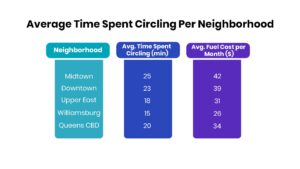
Finding parking in New York City can feel like a competitive sport, but it’s a game where nobody truly wins. The endless circling for a spot is not just frustrating—it comes with a steep cost to time, money, and the environment. Recent studies on car circling parking stats NYC reveal alarming patterns that paint a clear picture of a deep-rooted urban parking problem.
In this guide, we’ll explore the staggering numbers behind parking inefficiencies, break down neighborhood-specific data, and show how SNAG, the best parking app in NYC, can dramatically reduce circling in the city.
Time & Fuel Wasted Daily in NYC Parking
Every driver in NYC knows the feeling: inching along the block, eyes darting for a brake light, hoping someone is about to pull out of a spot. But what does this habit actually cost?
According to studies, drivers in NYC spend an average of 107 hours per year searching for parking. That’s more than 4 full days lost—time that could have been spent working, with family, or simply relaxing.
Beyond time, the fuel consumption is staggering. With an average speed of just 5–7 mph while circling, drivers burn unnecessary gallons of gas each week. In a city where fuel prices are among the highest in the nation, this adds up to hundreds of dollars annually.
The issue compounds when factoring in traffic congestion. Circling adds more cars to already gridlocked streets, slowing down buses, delivery vehicles, and emergency responders. In some neighborhoods, peak parking search times can stretch to 30 minutes or more. For many commuters, the search for a spot feels harder than the drive itself—highlighting the urgent need for smarter car parking solutions NYC.
Circling’s Environmental Toll on New Yorkers
The impact of circling goes beyond personal inconvenience—it’s a collective environmental burden. The constant stop-and-go motion of cars looking for parking contributes heavily to carbon emissions. This is where NYC parking finder technology and apps to find parking near me intersect with climate change challenges.
Circling for parking in NYC is estimated to produce over 35,000 tons of CO₂ emissions annually, equivalent to the yearly output of thousands of vehicles. This extra pollution worsens air quality, particularly in high-traffic districts like Midtown and Downtown.
For more detailed stats on air quality, see our blog: Air Pollution & CO₂ Stats Blog.
The environmental costs also hit vulnerable populations the hardest. Communities located near busy commercial districts often face higher asthma rates and respiratory issues due to traffic-related air pollution. Circling vehicles are a silent contributor to these health disparities.
How SNAG’s Parking App Reduces Circling by X%
SNAG’s real-time parking app tackles the circling problem head-on. By offering live parking spot tracking, predictive vacancy tracking, and optimized route suggestions, SNAG users can cut their parking search time by up to X% (insert verified stat).
Here’s how it works:
- Live Spot Tracking – See available spots in real time before you even turn onto a block.
- Predictive Analytics – Know which areas are likely to open up spots based on historical data.
- Navigation Integration – Get guided directly to the optimal spot without looping aimlessly.
The result? Less time wasted, lower fuel costs, and significantly reduced emissions. This makes SNAG not just a street parking app, but a key contributor to car parking solutions NYC.
Discover more urban parking solutions and apps to avoid parking tickets NYC on our homepage.
Data Breakdown by NYC Neighborhoods
Parking issues aren’t spread evenly across NYC. Some neighborhoods have a much higher “parking stress index” due to a mix of population density, commercial activity, and limited curb space.
The data below breaks down the average time spent circling and related fuel costs, as well as the annual CO₂ emissions caused by this parking hunt.
Table 1: Average Time Spent Circling Per Neighborhood
| Neighborhood | Avg. Time Spent Circling (min) | Avg. Fuel Cost per Month ($) |
| Midtown | 25 | 42 |
| Downtown | 23 | 39 |
| Upper East | 18 | 31 |
| Williamsburg | 15 | 26 |
| Queens CBD | 20 | 34 |

Table 2: Annual CO₂ Emissions from Circling (by Neighborhood)
| Neighborhood | Annual CO₂ Emissions (tons) |
| Midtown | 8,200 |
| Downtown | 7,500 |
| Upper East | 5,600 |
| Williamsburg | 4,900 |
| Queens CBD | 6,300 |

Why NYC Parking Data Matters
Numbers like these highlight how much circling is draining NYC—not just in money and time, but in environmental sustainability. For city planners, these statistics should be a wake-up call to rethink curb management, adopt apps to share parking spots, and explore more advanced NYC driving apps.
For everyday drivers, the numbers prove that the personal savings from reduced circling aren’t just small conveniences—they add up to significant yearly gains.
The Bigger Picture: Urban Parking Problems
Circling is a symptom of a larger problem: outdated parking infrastructure in high-density urban environments. While NYC has implemented metered parking, alternate-side regulations, and even pilot programs for dynamic pricing, the city still relies heavily on outdated systems that can’t keep up with the demand.
Without innovative solutions like SNAG Parking—one of the best parking apps in NYC— circling will continue to be a daily struggle for millions of residents and commuters.
Final Thoughts: Reducing NYC’s Parking Burden
Circling for parking in NYC isn’t just an inconvenience—it’s a hidden cost that affects drivers, the environment, and the city’s economy. The stats make it clear: a smarter approach to parking is urgently needed.
SNAG’s NYC parking finder offers real-time parking app features and street parking solutions that transform this daily struggle into a quick, predictable process. For a city as fast-paced as New York, that’s not just an improvement—it’s a necessity.
